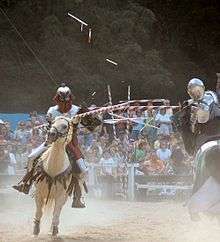Theatrical jousting

Coined in the late 20th century by American stunt performer Kent Shelton, the term theatrical jousting refers to a form of live entertainment in which a medieval jousting tournament is recreated in conjunction with a scripted performance. Alternative terms are "jousting reenactment" or "choreographed jousting".
The Hanlon-Lees Action Theater is credited with developing the theatrical joust format in 1979; its first appearance was at the New York Renaissance Faire in Tuxedo, New York. This type of performance has become very popular at various renaissance fairs by the early 2000s.[1]
Typically a three-act affair, the theatrical joust consists of
- a display of skill;
- a mock battle which results in a verbal challenge;
- an armed joust on horseback, often "to the death."
A variety of colorful characters, either villainous or heroic, give the audience (which is usually divided into sectors based upon the number of "knights") a particular person to root for or against.
As the show must be repeated on a daily or weekly basis, all fights are carefully choreographed and rehearsed. Horses must be trained to withstand such peculiarities as the clatter of steel weaponry, the occurrence of a rider being knocked from the saddle, and the roar of large crowds. Special makeup and/or property effects are often incorporated into the performance to provide the illusion of violent death or shattering equipment.
References
- Leeser, Kevin (2006). Renaissance Men (documentary film), 3 Alarm Carnival Productions.
| Wikimedia Commons has media related to Jousting reenactment. |